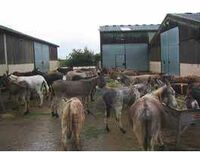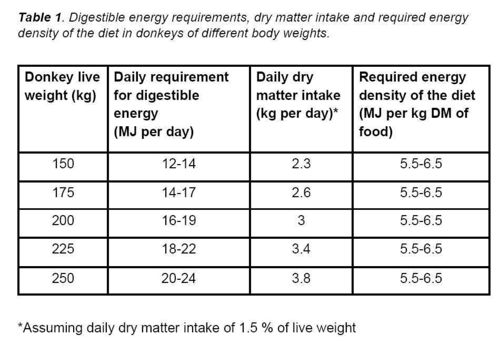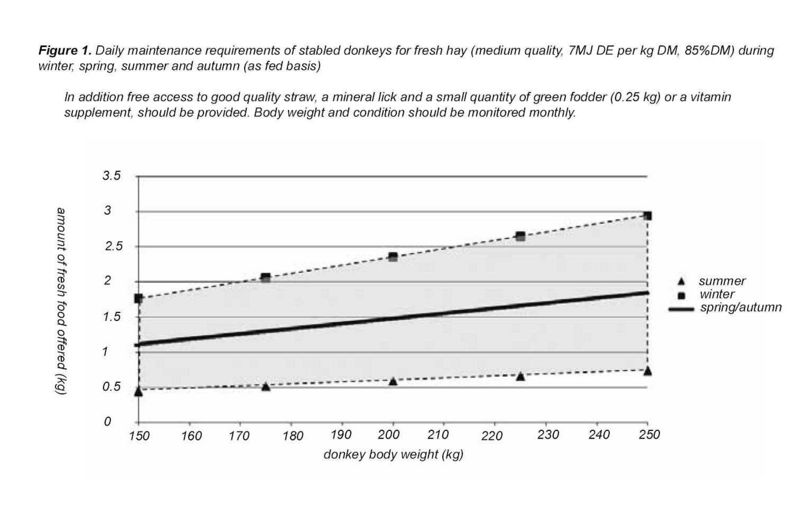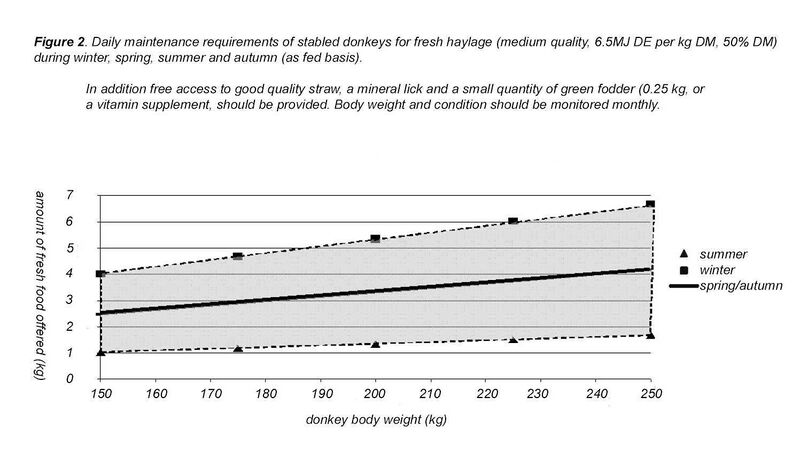Energy Requirements - Donkey
| This article has been peer reviewed but is awaiting expert review. If you would like to help with this, please see more information about expert reviewing. |
Introduction

Energy is required both to live (i.e. for maintenance), and to grow, work, lactate and reproduce (i.e. for production). Donkeys derive a principle source of their energy from non‑structural carbohydrates, mainly starch, and structural carbohydrates, which are a major constituent of fibre. Foods derived from grains, such as oats, barley and wheat, are rich in starch, which is broken down to yield glucose. Fibrous feeds are rich in the structural carbohydrate cellulose, which is broken down to yield volatile fatty acids (VFA). Both glucose and VFA are used by the donkey to supply its body with energy. As well as carbohydrates, the donkey can use dietary fats and proteins as a source of energy.
If energy intake exceeds the energy requirements, the surplus is stored as fat. It is important to know the energy requirements of donkeys in order to avoid under- or over-feeding. Typically, donkeys in tropical countries are under-fed and have body condition scores of less than 3. In temperate regions donkeys are generally over-fed (condition score 3 to 4). The consequences of both acute and chronic over-feeding in donkeys are very serious and can result in death. Management of weight loss in overweight donkeys is particularly problematic, because rapid loss in condition is likely to trigger hyperlipaemia, a disease that can be fatal. Prevention of obesity is better than cure.
Recent research
Recent research funded and carried out by the Donkey Sanctuary has established scientifically validated guidelines for donkeys kept in temperate and in tropical climates.

Mature donkeys that are kept at maintenance levels (neither gaining nor losing weight) require between 80-95 KJ of digestible energy (DE) per kilogram of live weight per day (see Table 1 above, and Figures 1 and 2 for practical examples). In temperate climates, the upper value will apply during the winter months of December to February, when the energy requirement of donkeys tends to increase slightly. The lower value will apply during the height of summer.


In order to formulate an appropriate ration for donkeys, it is necessary to estimate how much dry matter a donkey will eat per day. In the recent study at the Donkey Sanctuary, dry matter intakes of between 1.3-1.7% of live weight were measured in donkeys fed on straw and hay (straw was available ad libitum). Other published studies have reported dry matter intake values in donkeys of between 0.9% and 2.5% that were given a variety of feeds; the higher values in this range were recorded in donkeys fed on chopped lucerne. A reasonable assumption of the appetite limit of a typical donkey is therefore approximately 1.5% of its live weight in dry forage per day (i.e. a 100 kg donkey can consume 1.5 kg of dry food per day).
It is important to satisfy the energy requirement of donkeys, their appetite and their psychological need to spend large parts of the day foraging. For most of the year a ration that contains 70-75% barley straw and 25-30% of moderate quality hay will supply all the energy requirements of donkeys. During the winter when energy requirements increase, the proportion of hay needs to be increased to 50-75% and the proportion of straw decreased to 25-50%.
In practice, donkeys select hay in preference to straw, therefore simply by limiting the amount of hay fed to the required levels and offering straw ad libitum, animals are unlikely to exceed their energy requirements.
A mineral supplement will also be required and some source of vitamins, either in the form of a small quantity of fresh green fodder, for example, 200 g of chopped alfalfa, or a commercial vitamin mix.
A careful eye should be kept on the quality of fodders being fed; the digestible energy value can vary considerably between bales and consignments. Always check that fodder is of medium to good quality (more than 7 MJ DE per kg DM) before feeding. Fodders that are mouldy or excessively stemmy are unlikely to provide the donkey with all its energy requirements and should be avoided.
All these recommendations should be backed up by regular body condition scoring of donkeys. Using these guidelines, it is apparent that the vast majority of healthy donkeys kept at maintenance levels only require to be fed medium quality hay and have no requirement for supplementary concentrate feed, even during winter.
Donkeys with special requirements
When donkeys are growing, pregnant or lactating, extra energy needs to be fed. Research in this area has still to be conducted, but general guidelines are provided below.
Growing donkeys
- Ideally, immature growing donkeys should be provided with sufficient energy to allow them to grow at a steady rate, avoiding periods of rapid growth acceleration or retardation
- Providing too much energy to a growing donkey, especially when not balanced with adequate protein, calcium and phosphorus, may result in the development of orthopaedic problems
- The available time for young donkeys to attain their full mature stature is approximately two to three years
- Growing donkeys may face problems at weaning and during their first winter and some supplementation with concentrate feed may be required in order to avoid prolonged growth checks or permanent stunting
- Pasture-fed immature donkeys are unlikely to require energy supplements, but should be given access to mineral licks
Pregnant donkeys
- In pregnant donkeys, the demands of the growing foetus only exceed the normal requirements in the final three months of pregnancy
- Digestible energy allowances should be increased by 11% above maintenance in the ninth month, 13% in the penultimate month and 20% in the final month of pregnancy
Lactating donkeys
- Lactating jennies are likely to lose weight (½ to 1 body condition score point) during the first two months when their foals are suckling, even when they are receiving moderate feed supplementation
- Preparation for this loss should be made in the final months of pregnancy by allowing pregnant jennies of body condition score 3 to gain ½-1 point of body condition by additional feeding (i.e. at foaling they should have a body condition of 3½ to 4)
- The jenny should receive sufficient additional feeding during her first two to three months of lactation to minimise body weight loss, aiming to achieve a body condition score of 3 for the remainder of the pre-weaning period
References
- Smith, D. and Wood, S. (2008) Donkey nutrition In Svendsen, E.D., Duncan, J. and Hadrill, D. (2008) The Professional Handbook of the Donkey, 4th edition, Whittet Books, Chapter 1
|
|